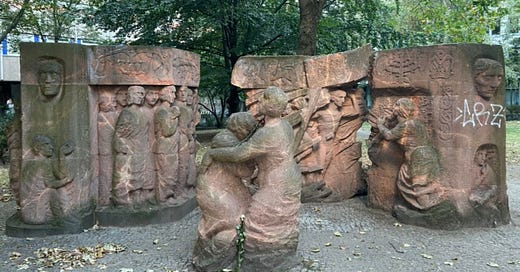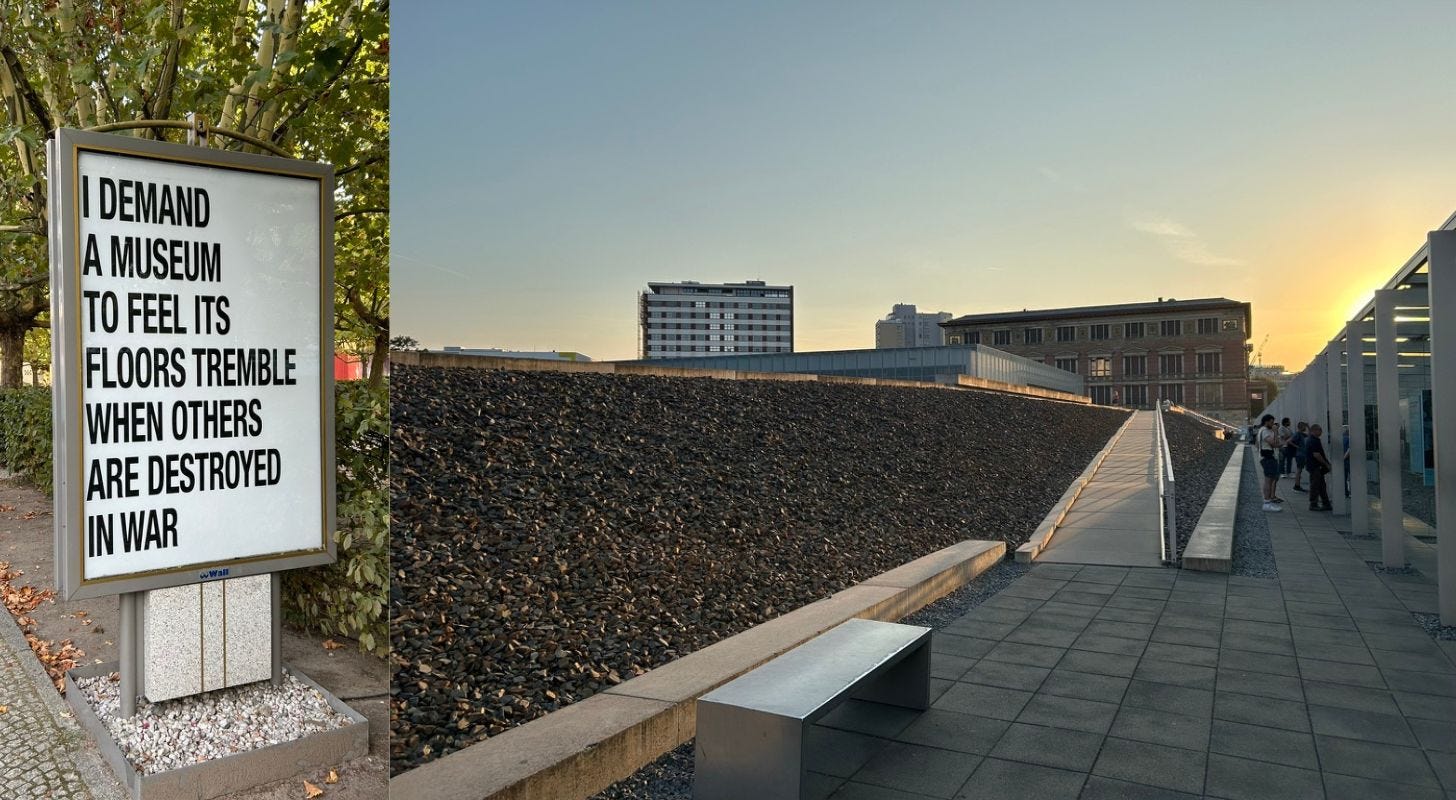🌹🎶 Roses of Berlin - 1: The Women of Rosenstraße - 1943
The first in a series of rambles about Women of Berlin
🌹🎶 Roses of Berlin
A series of rambles about Women of Berlin
Wandering the streets of Berlin this September, I wondered at the tales and trails left by women who changed the course of the city and herstory. We’ll be meeting everyday heroines, pious saints, dynastic Queens and political activists as I share weekly posts about my discoveries, beginning today with my first steps along the street I was staying in, Rosenstraße.
Block der Frauen - Block of Women, Rosenstrasse Monument - Ingeborg Hunzinger, 1995
1. The Women of Rosenstraße - 1943
Emerging on my first dazzlingly bright September morning in Berlin, I discovered that I was a Rose on Rose Street, my hotel seated alongside a site of a renowned female resistance to Nazi oppression. Der Rosenstraßen-Protest is commemorated in two red Litfaß columns at either end of the street and Block der Frauen, Ingeborg Hunzinger’s rose-coloured sculptures in a small park at the site of the Altes Synagogue, which was destroyed by bombing in 1942.
In 1935, the Nuremberg Laws deprived Jews of citizenship and prohibited sexual relations and intermarriage between Jews and "persons of German or related blood.” Intermarried couples were divided in hierarchies - those with a Jewish wife and Aryan husband with baptised children were granted the most leniency, whilst those with a Jewish husband and children were treated most harshly. Public humiliations ensued, as couples were paraded with their heads shaved, carrying signs such as ‘Ich bin ein Rasseschänder / I am a race defiler.’ Denied work and ostracised from society, the majority chose not to divorce. Some, including famous actor Joachim Gottschalk and his Jewish wife and their eight-year-old son, committed joint suicide. As the war progressed, increasing numbers of intermarried Jews and their children were taken into ‘protective custody’ and deported to concentration camps.
Photo: (L-R) Litfaß column on Rosenstraße and a park bench alongside Block der Frauen, sculpted by Hunzinger - Jews were not allowed to sit on park benches.
On the evening of February 27th 1943, the remaining Jewish community of Berlin were rounded up by the Nazis. Whilst the majority were murdered in gas chambers within days, 1800 Jews who had been classified Priviligierte Mischehe / Privileged Intermarriage were detained in what had been the Jewish Welfare Administration in Rosenstraße.
Searching for her husband Rudi, Elsa Holzer found herself amidst an estimated crowd of 600 women shouting ‘Give Us Our Husbands Back.’ “People flowed back and forth. The street was full. This short little street was black with people. They were like a wave, and they moved like a body, a swaying body.” Despite threats of violence, the protests continued daily until 6th March, briefly interrupted by an air raid, until Gauleiter of Berlin, Joseph Goebbels urged Hitler to release the detainees. Despite Nazi attempts to suppress the story, it soon reached the international press and remains an outstanding example of courageous resistance.
“We acted from the heart and look what happened” - Elsa Holzer
Although the majority of the protestors were women, some non-Jewish men, such as Dorothea Woiczechowski-Fried’s father pleaded for the release of their wives. Erika Lewin, daughter of Jewish father Josef, describes being locked in a windowless room with fifty women and a bucket in the corner, unaware that her Protestant mother Else was protesting outside. Susanne Schwarz describes similar conditions which left her father unrecognisable on release: “my father had had a nervous breakdown in the Rosenstraße and had been lying on a stretcher in the cellar for the last few days. The conditions had been intolerable, with about sixty men sharing a small room night and day, without being able to sit down. The hallucinations he had there, while lying on the stretcher, left a deep impression on him for many years.”
Ruth Gross-Pisarek recalls waving to her father, photographer Abraham Pisarek, who on release from Rosenstraße, was forced to undertake hard labour and suicide missions clearing furniture from houses containing unexploded bombs. For her, the women of Rosenstraße embodied the words of Ruth, the first Jewish convert in the Tanakh (Hebrew Bible)
“Do not tell me to leave you or to turn back from following you, for where you go I will go, and where you stay I will stay. Your people will be my people and your God my God. Where you die I will die, and there I will be buried. Only death will separate you and me.” - Ruth, 1:16–17
Photograph: above and below: Topographie des Terrors Museum
As the setting sun cut sharp shadows across rugged remnants of the Berlin Wall at the end of my first day, I visited the Topographie des Terrors Museum. The exhibition starts in a sunken walkway between the Wall and a desolate gravel area containing the foundations of the Gestapo HQ Prison, where thousands were interrogated and tortured in terrible conditions. The Museum details the brutal efficiency with which the Nazi party gained and maintained power through propaganda, division, humiliation, persecution, torture and mass murder. Between 1938-45, the societies, governments and legal systems of twenty European countries were warped beyond recognition to fit their terrifying regime. Six million Jews and millions of non-Jews were murdered, including those considered ‘non-Aryan’ or ‘inferior’- including Roma, Sinti, Slavs, black, homosexual and disabled people, and political or ideological opponents including artists, communists, social democrats and Jehovahs Witnesses. Individuals and communities who resisted faced horrific reprisals with far-reaching consequences - Colonel Claus Stauffenberg’s famous attempt to assassinate Hitler in 1944 was followed by 7,000 trumped up trials resulting in 4,980 murders.
Within a seemingly insurmountable reign of hate, the Rosenstraße Protest was an extraordinary act of courageous love by ordinary wives and mothers.
“The women who risked their lives in the worst days of tyranny should embolden
the rest of us to stand up against injustice wherever it occurs.”
- Susan Neiman, American philosopher and board member of The Rosenstraße Foundation










A moving and evocative piece, Katie.
Beautifully expressed, as always.